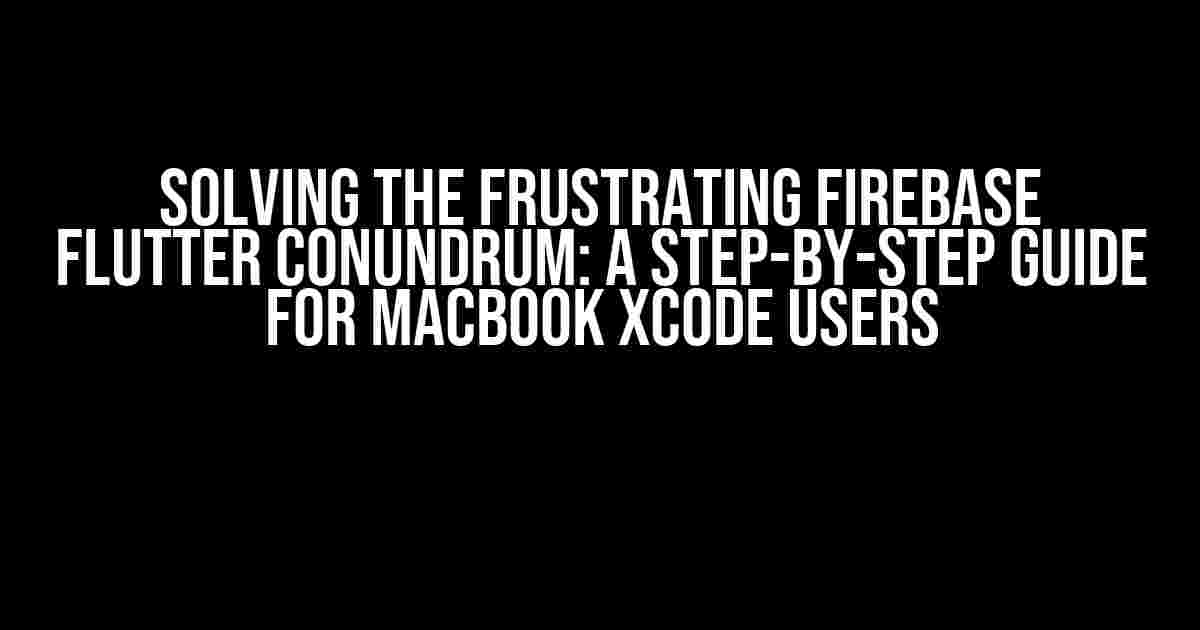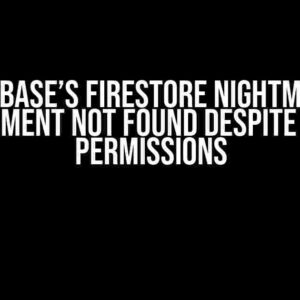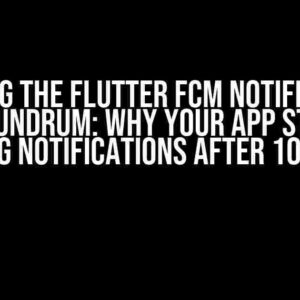- The Problem: “I can’t run my Flutter project when I try to integrate with Firebase on MacBook with Xcode”
- Prerequisites: Getting Your Environment in Check
- Step 1: Verify Your Flutter Project Configuration
- Step 2: Initialize Firebase in Your Flutter Project
- Step 3: Set Up Your Xcode Project
- Step 4: Integrate Firebase with Your Flutter Project
- Troubleshooting Common Issues
- Conclusion
The Problem: “I can’t run my Flutter project when I try to integrate with Firebase on MacBook with Xcode”
Are you stuck in the depths of desperation, unable to integrate Firebase with your Flutter project on your trusty MacBook, only to be met with a sea of errors and frustration? Fear not, dear developer, for you are not alone! Many have walked this treacherous path before, and with this comprehensive guide, you’ll be up and running in no time.
Prerequisites: Getting Your Environment in Check
Before we dive into the meat of the issue, let’s ensure your environment is set up for success:
- Flutter 2.0 or later installed on your MacBook
- Xcode 12 or later installed on your MacBook
- Firebase project created and set up in the Firebase console
- Firebase FlutterFire CLI installed (
flutter pub global add firebase_cli)
Step 1: Verify Your Flutter Project Configuration
In your Flutter project directory, open the pubspec.yaml file and add the following dependencies:
dependencies:
flutter:
sdk: flutter
firebase_core: "^1.10.0"
firebase_auth: "^3.1.0"
firebase_firestore: "^3.1.0"
Make sure to adjust the version numbers according to your Firebase project requirements.
Step 2: Initialize Firebase in Your Flutter Project
Open a terminal in your Flutter project directory and run the following command to initialize Firebase:
flutter pub get flutter pub global run firebase_cli:core_init
This will prompt you to select your Firebase project and configure the necessary files.
Step 3: Set Up Your Xcode Project
Open your Flutter project in Xcode by navigating to the project directory and opening the .xcworkspace file.
Configure the Xcode Project Settings
In Xcode, navigate to the project settings by clicking on the project name in the top-left corner, then selecting Runner from the targets list:
| Target Membership | Ensure the GoogleService-Info.plist file is added to the target membership. |
| Capabilities | Enable Keychain Sharing and Background Modes (for Firebase Cloud Messaging). |
| Build Settings | Set the OTHER_LDFLAGS flag to -ObjC. |
Step 4: Integrate Firebase with Your Flutter Project
Create a new file called firebase_config.dart in your Flutter project, and add the following code:
import 'package:firebase_core/firebase_core.dart'; import 'package:firebase_auth/firebase_auth.dart'; import 'package:cloud_firestore/cloud_firestore.dart'; Futuremain() async { WidgetsFlutterBinding.ensureInitialized(); await Firebase.initializeApp(); runApp(MyApp()); } class MyApp extends StatelessWidget { @override Widget build(BuildContext context) { return MaterialApp( title: 'Firebase Flutter Demo', home: HomeScreen(), ); } } class HomeScreen extends StatelessWidget { @override Widget build(BuildContext context) { return Scaffold( appBar: AppBar( title: Text('Firebase Flutter Demo'), ), body: Center( child: ElevatedButton( onPressed: () async { await FirebaseAuth.instance.signInAnonymously(); }, child: Text('Sign in with Firebase'), ), ), ); } }
This code initializes Firebase, sets up a basic Flutter app, and demonstrates anonymous sign-in with Firebase Authentication.
Troubleshooting Common Issues
Error: “The GoogleService-Info.plist file is missing.”
Solution: Ensure the GoogleService-Info.plist file is added to the Xcode project, and the file is correctly configured with your Firebase project settings.
Error: “FirebaseApp.configure() – No app configuration was found.”
Solution: Verify that the GoogleService-Info.plist file is correctly configured, and the Firebase project is initialized in your Flutter project using the firebase_cli command.
Error: “Error launching application on iPhone/iPad.”
Solution: Ensure the Xcode project settings are correctly configured, and the target membership is set up correctly. Try cleaning and rebuilding the project by running flutter clean and flutter pub get in the terminal.
Conclusion
By following this comprehensive guide, you should now be able to successfully integrate Firebase with your Flutter project on your MacBook using Xcode. Remember to double-check your project configuration, Firebase setup, and Xcode project settings to avoid common pitfalls. If you still encounter issues, refer to the official Firebase and Flutter documentation for additional troubleshooting resources.
Happy coding, and may the Firebase force be with you!
Here are 5 Questions and Answers about “I can’t run my Flutter project when I try to integrate with Firebase on MacBook with Xcode”:
Frequently Asked Question
Stuck on integrating Flutter with Firebase on your MacBook with Xcode? Don’t worry, we’ve got you covered!
Q1: Why does my Flutter project refuse to run after integrating with Firebase on my MacBook with Xcode?
A1: Ah, frustrating, right? This might be due to a missing or incorrect configuration of the GoogleService-Info.plist file. Double-check that you’ve added the file to your project and configured it correctly. Also, ensure that the Firebase SDK is properly installed and imported in your project.
Q2: I’ve followed the Firebase integration tutorial, but I still get a “firebase_core” not found error. What’s going on?
A2: Hmm, that’s weird! It’s possible that the Firebase Core plugin isn’t installed or isn’t properly linked to your project. Try running `flutter pub get` and then `flutter run` to ensure that all dependencies are installed. If the issue persists, check your pubspec.yaml file to ensure that the Firebase Core plugin is listed under dependencies.
Q3: After integrating Firebase, my project builds successfully, but it crashes on launch. What could be the reason?
A3: Ouch, that’s not what you want to see! This could be due to a misconfigured Firebase instance or an incorrect Firebase initialization. Review your Firebase initialization code to ensure it’s correct and properly configured. Also, check the Xcode console for any error messages that might give you a hint about what’s going wrong.
Q4: I’ve followed all the steps, but I still can’t get my Firebase project to work on my MacBook with Xcode. What’s the next step?
A4: Don’t give up! It’s time to debug and troubleshoot. Enable debug logging in your Flutter project by setting the `flutterdebug` environment variable to `true`. This will help you identify any issues or errors that might be causing the problem. Additionally, you can try resetting the iOS simulator or restarting Xcode to see if that resolves the issue.
Q5: Are there any specific Xcode settings or configurations I need to be aware of when integrating Firebase with my Flutter project?
A5: Yes, there are a few Xcode settings you should check. Ensure that the correct Team and Bundle Identifier are set in your Xcode project settings. Also, make sure that the Firebase SDK is properly linked to your target in the Xcode project settings. Finally, review the Capabilities tab to ensure that the necessary capabilities (e.g., Push Notifications) are enabled.




